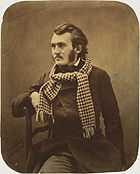Nadar (photographer)

Nadar was the pseudonym of Gaspard-Félix Tournachon (6 April 1820 – 23 March 1910),[1] a French photographer, caricaturist, journalist, novelist, and balloonist.
Examples of Nadar's photographic portraits are held by many of the great national collections of photographs.
Life

._-_D%60apr%C3%A8s_les_renseignements_fournis_par_M._Nadar._Gravure_1863.jpg)
Nadar was born in April 1820 in Paris (though some sources state Lyon). He was a caricaturist for Le Charivari in 1848. In 1849 he created the Revue comique and the Petit journal pour rire. He took his first photographs in 1853 and in 1855 opened a photographic studio at 25 Boulevard des Capucines[2] and in 1858 he became the first person to take aerial photographs. This was done using the wet plate collodion process, and since the plates had to be prepared and developed while the balloon was aloft Nadar experienced problems caused by the chemical action on the plates of gas escaping from the balloon, eventually overcome by using a gas-proof cotton cover over the balloon basket.[3] He also pioneered the use of artificial lighting in photography, working in the catacombs of Paris.

In 1863, Nadar commissioned the prominent balloonist Eugène Godard to construct an enormous balloon, 60 metres (196 ft) high and with a capacity of 6,000 m3 (210,000 cu ft), and named Le Géant ("The Giant"),[4] thereby inspiring Jules Verne's Five Weeks in a Balloon. The "Géant" was badly damaged at the end of its second flight, leading Nadar to the conviction that the future belonged to heavier-than-air machines. Later, "The Society for the Encouragement of Aerial Locomotion by Means of Heavier than Air Machines" was established, with Nadar as president and Verne as secretary. Nadar was also the inspiration for the character of Michael Ardan in Verne's From the Earth to the Moon.

On his visit to Brussels with the Géant, on 26 September 1864, Nadar erected mobile barriers to keep the crowd at a safe distance. Up to this day, crowd control barriers are known in Belgium as Nadar barriers.
During the Siege of Paris in 1870–71 Nadar was instrumental in the organisation of balloons flights carrying mail to reconnect the besieged Parisians with the rest of the world, so establishing the world's first airmail service.[5]
In April 1874, he lent his photo studio to a group of painters to present the first exhibition of the Impressionists . He photographed Victor Hugo on his death-bed in 1885. He is credited with having published (in 1886) the first photo-interview (of famous chemist Michel Eugène Chevreul, then a centenarian), and also took erotic photographs.
From 1895 until his return to Paris in 1909, the Nadar photo studio was in Marseilles (France).
Nadar died in 1910, aged 89. He was buried in Père Lachaise Cemetery in Paris.
Gallery
-

Georges Boulanger
-

Caricature of Balzac, 1850
-

Camille Corot
-

Jules Favre in 1865
-

Léon Gambetta in 1870
-

Gustave Doré (1859)
-

Alexandre Dumas, père
-

Ilya Mechnikov
-

Nasser al-Din Shah Qajar, king of Persia 1848-1896
-

Henri Rochefort
-

George Sand (1864)
-

Marquis de Galliffet, the fusilleur de la Commune
-

Le Bris and his flying machine, Albatros II
-

Nadar (Gaspard-Félix Tournachon) - Self-portrait
-
Nadar's son, photographed by Nadar with members of the Second Japanese Embassy to Europe in 1863.
-

The future painter Charles Crodel with a sketch-book, photograph by Nadar, Marseille, 21 rue de Noailles, 1905
See also
- Prix Nadar, French photojournalism prize given in Nadar's name
- Mononymous person
- Michel Ardan
Citations
- ↑ "La Mort de Nadar". l'Aérophile (in French): 194. 1 April 1910.
- ↑ Holmes 2013, p.158
- ↑ Holmes 2013, p.159
- ↑ Holmes 2013, p. 164
- ↑ Holmes 2013, p. 260
References
- Richard Holmes, Falling Upwards: London: Collins, 2013.
External links
| Wikimedia Commons has media related to Félix Nadar. |
- Works by Nadar at Project Gutenberg
- Works by or about Nadar at Internet Archive
- Works by or about Gaspard-Félix Tournachon at Internet Archive
- 1867 Caricature of Nadar by André Gill
- Article about Nadar by Bruce Sterling
- Great article about Nader by Roger Cicala
- Fostinum: Nadar numerous photographs by Nadar
|








.jpg)





.jpg)

